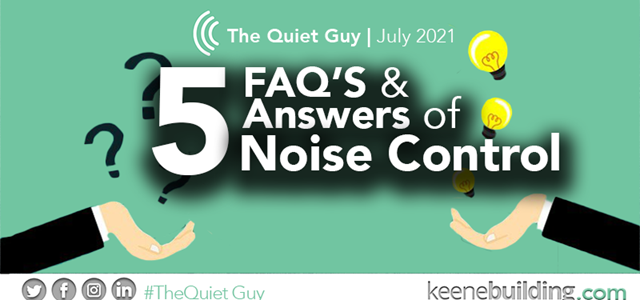
How do I choose a sound mat?
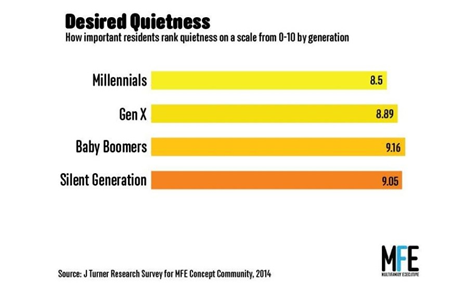 Is the developer building these for investment, or build and resell? How long will they hold the property for? If the developer is holding onto them, then they should be concerned about maintaining long term tenants, therefore designing a system that will not risk losing tenants is key. If they are building the units to “flip” or sell off in the short term, then they might not be as interested in investing a better acoustical system.
Is the developer building these for investment, or build and resell? How long will they hold the property for? If the developer is holding onto them, then they should be concerned about maintaining long term tenants, therefore designing a system that will not risk losing tenants is key. If they are building the units to “flip” or sell off in the short term, then they might not be as interested in investing a better acoustical system.
Keene Building Products, has all of the necessary products and options for all conditions to meet all needs and expectations, for both above the floor and below the ceiling for Noise Control in Multi-Family Construction.
OUR RECOMMENDATION:
- Quiet Qurl® Sound Control Mats with Muffling Technology
- QQ Step Soft™ - Recycled Noise Control Underlayment For Concrete Slab Construction and Hard-Surface Flooring Noise Reduction
- Cylent Assurance™ Clip - A Sound Isolating Clip for Any RC-1 Channel, Designed to achieve Luxury Living Standard
What are factors for good sound control?
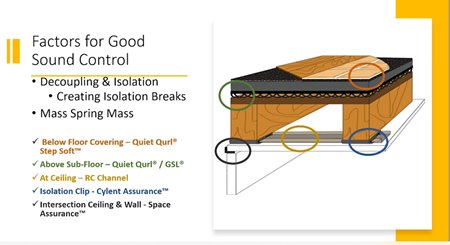 This image shows the factors and opportunities for good sound control, which utilize decoupling and isolation. This is based on how we best decouple and isolated the assembly and create what we call the mass spring mass. When we look at a floor ceiling assembly, in wood construction, we typically see five different opportunities to create mass spring mass.
This image shows the factors and opportunities for good sound control, which utilize decoupling and isolation. This is based on how we best decouple and isolated the assembly and create what we call the mass spring mass. When we look at a floor ceiling assembly, in wood construction, we typically see five different opportunities to create mass spring mass.
How can I avoid noise complaints?
Once folks start complaining about sound control in a multi-family apartment environment, it is past the point of no return to remediate the problem. Good sound control starts at the planning stage, well before construction begins.
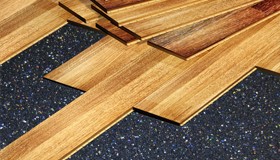 There are not a great deal of remedies at your disposal to mitigate sound problems after construction. The best and most economical option is to address the problem, once a tenant moves out. At that point you likely will need to replace some or all the floor covering(s). Utilizing a topically added recycled rubber sound mat, like Quiet Qurl Step SoftTM, prior to the installation of the new floor covering(s) is the best option. Quiet Qurl Step Soft comes in a variety of thicknesses, depending upon the amount of noise you want to attenuate and your budget. These types of products, typically do an excellent job of helping to mitigate high frequency noise (think high heels on ceramic tile), but not so much with the more problematic low frequency thud noises. Quiet Qurl Step Soft can be placed on the substrate then have finished floor covering directly applied over it.
There are not a great deal of remedies at your disposal to mitigate sound problems after construction. The best and most economical option is to address the problem, once a tenant moves out. At that point you likely will need to replace some or all the floor covering(s). Utilizing a topically added recycled rubber sound mat, like Quiet Qurl Step SoftTM, prior to the installation of the new floor covering(s) is the best option. Quiet Qurl Step Soft comes in a variety of thicknesses, depending upon the amount of noise you want to attenuate and your budget. These types of products, typically do an excellent job of helping to mitigate high frequency noise (think high heels on ceramic tile), but not so much with the more problematic low frequency thud noises. Quiet Qurl Step Soft can be placed on the substrate then have finished floor covering directly applied over it.
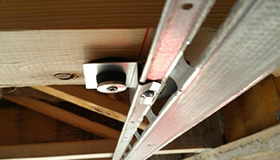 To really do a better job of mitigating the low frequency thud noise, you need to address this from the ceiling side of the floor ceiling assembly. This is typically much more costly. The simplest way to accomplish that would be to add an additional ceiling to the existing ceiling and utilize Keene Building Products Cylent AssuranceTM Clip. While this method will prove to be a bit more costly, it will dramatically increase the sound attenuation of low frequency noise through the assembly.
To really do a better job of mitigating the low frequency thud noise, you need to address this from the ceiling side of the floor ceiling assembly. This is typically much more costly. The simplest way to accomplish that would be to add an additional ceiling to the existing ceiling and utilize Keene Building Products Cylent AssuranceTM Clip. While this method will prove to be a bit more costly, it will dramatically increase the sound attenuation of low frequency noise through the assembly.
THE BEST SOLUTION IS BETTER PLANNING. HOWEVER, WHEN FACED WITH NOISE PROBLEMS DUE TO IMPROPER PLANNING, BOTH QUIET QURL STEP SOFT AND THE CYLENT ASSURANCE CLIP PROVIDE VIABLE SOLUTIONS TO YOUR NOISE PROBLEM.
How can I increase sound performance without increasing cost?
Traditionally, to increase sound performance, we need to increase the thickness of the sound mat and thus increase the thickness of the gypsum concrete. This also increases the dead load weight on the floor ceiling assembly and increases the cost. With Keene’s MT technology we can decrease the thickness of the Quiet Qurl, decrease the thickness of the gypsum and increase the sound performance.
Adding Keene’s MT solution to any of Quiet Qurl products is an extremely cost-effective solution for enhanced sound control in any floor ceiling assembly and gives architects and developers more choices in times when more cost-effective choices are needed.
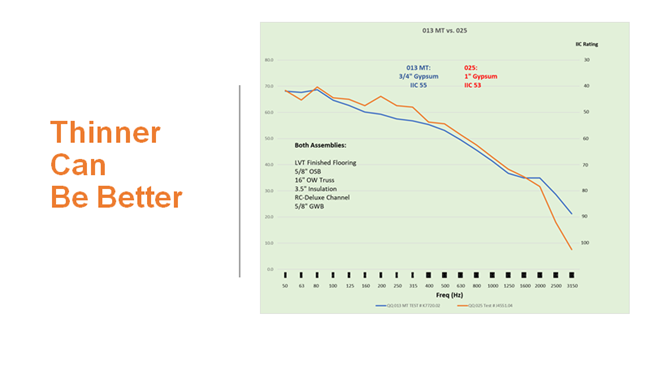
What is the best system to use in Cross Laminated Timber Construction?
One of the major challenges from CLT is noise control. Since the floor panel, also acts as the ceiling, there are no opportunities for the mass spring mass of effective sound control on the bottom of the assembly Both STC and IIC ratings are a big challenge, often making it difficult to achieve Building Code minimum standard of 50. Even when 3/4" sound mat is used in combination with 2 inches of gypsum cement the 50 STC and IIC code minimum, cannot be achieved.
Here at Keene Building Products and Dependable we have recently done some preliminary testing with a combination double layer sound mat utilizing our Quiet Qurl® entangled net, with our patented MT (Muffling Technology) and Step Soft™ recycled rubber, were we have achieved some extremely encouraging results. When also utilizing a double pour, in conjunction with our sound mats, we were able to achieve even greater results. We have published these results in our most recent upgrade to our Acoustic Product Guide:
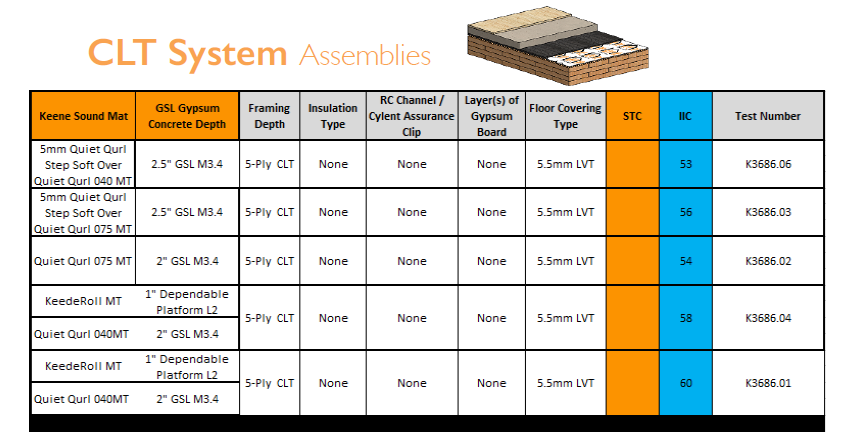
The combination of the MT fabric in conjunction with the more solid mass of the recycled Step Soft and Quiet Qurl entangled net sound mats provide the mass spring mass necessary for sound attenuation in the CLT panels. Only Keene and Dependable can create a one stop shop manufacturer of these products to produce these results and unique noise control solution for CLT construction.
For recent literature and test results see the Ceiling Acoustics section in our Acoustic Product Guide.
Contact Keene for more information and start using Noise Control Products in your system today!